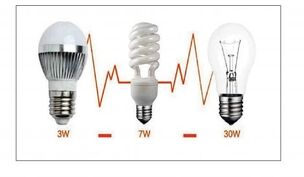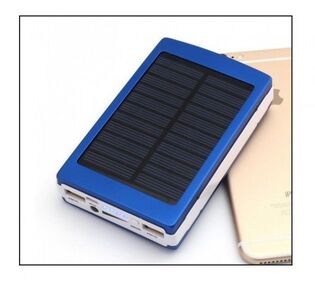Consumers are driven by rising energy prices and environmental considerations to save electricity. Consumers may see the environment as a wish or a scam, but if it comes at an additional price, it should be taken into account.
Of course, energy will not go anywhere, its use will increase, the number of resources will increase and the most dangerous resources will be replaced. Saving does not mean limitations, but wise use. You can economically spend a hundred kilowatts and waste a hundred watts.
Energy saving is achieved by the organization proper (not disturbing) its use, this is the result of activity planning. Charlatan devices and "methods" advertised on the Internet sometimes have nothing to do with storage. This method can only cause fires and electric shocks.
Decreased energy users
All electrical consumers can be classified in several ways by the amount of energy used (energy intensity). For example, in this way, in descending order:
- Heating devices;
- Lighting devices;
- Electric motor;
- Computer Science;
- Electronics and communication equipment.
Even at the household level, this classification is allowed: most electricity is used by kettles, stoves of various types - grills, toasters, electric stoves, then irons, dryers. Quite a lot of energy is spent for lighting purposes. Lights compete with refrigerators (compressor motors).
Ordinary home PCs also consume a lot of them, enough competitors for refrigerators. With this background, TV alarms, security and fire, and chargers for mobile communication devices use the least.
Converting electricity to heat is the most "significant" result that can be obtained, but it is also obtained with full efficiency. if such conversion is required. Iron efficiency is almost 100%. For light sources, the situation is much worse - even for LED lights, the efficiency is almost only 15%, (we can talk about close to 100% only for quantum phenomena in semiconductor LED crystals, the rest goes to wire heating and loss of additional equipment: driver)
Savings on heating devices
How to save energy without denying yourself the benefits of civilization? Because, as we have seen, heating devices "take in electricity", this is the most important source to save. For them, the method of saving energy in daily life is indirect, but no less important. First of all, heat must be fully utilized. For example, it is very unwise to boil water in a metal tank in a cold room that does not need to be heated. It is better to do this where the heat will spread to the dwelling.
The heat generated must be maintained completely and for as long as possible due to the thermal insulation in the premises. In European countries, for example, Germany, they are even fined for poor insulation.
With the payment of various tariffs for energy and heat storage ability, the most useful are the night mode of operation of water heaters and other heating devices. During the day, heat will be stored at sufficient levels. This is especially useful if the occupants work or study during the day. In addition, by spending energy at night, users equate the load on the power grid, which has a positive impact on usability and operating costs. This allows us to expect cheaper prices.
Lighting savings

Let's start with a reminder to remember to turn off the lights in unnecessary places. And think about the location of the light source (preferably with professional help in this case) in all rooms, even if it is a utility room. Then we turn to the light sources available in our time.
First of all, it should be noted that we live in a fertile time of the rejection of gluttonous incandescent lamps, which are hotter than those illuminated. Extensive use of fluorescent light sources (daylight) provides very significant energy savings, two to three times.
Fluorescent lamps made in the form of 40 and 80 W tubes have been widespread before (since the 70s of the last century), but mainly in public and industrial buildings.
Modern "energy-saving" household fluorescent lamps at the E27 base are tubes similar to mercury and phosphorus vapors from the inner surface of glass. But they are rotated into circular circles and connected via miniature electronic weights located at the base and perform the same functions as the iron blockers and gas release starters performed previously.
But fluorescent lamps are already dense by LED lights, which use two to three times less energy than fluorescent lamps with the same luminous flux. They are still quite expensive than other types of lamps, but the market is not yet filled with new products. The cost pays off quickly due to the huge savings from its use.
Both fluorescent and LED bulbs have a very wide spectrum approaching daylight. This is due to the use of ultraviolet primary sources in both cases - LED lights also use light and ultraviolet light is converted into a mixture of all visible light colors. Only in LED lamps, ultraviolet light is produced not by mercury vapor atoms, but by semiconductor crystals.
An additional way to save energy while solving lighting problems is to turn on and off automatically. The person is forgetful, but the technique is not. The use of dimmers (brightness control devices), photo relays, timers and motion sensors will minimize unnecessary light costs.
All of these products are in-store, sold under warranty, certificates and instructions, and have long been the exclusive handicraft available only to qualified radio amateurs who make them for their home.
Electric motor
Electric motors are found in everyday life especially in refrigerators, washing machines and air conditioners. There are also pumps for heating systems and pumps for wells. All other cases: coffee grinders, drills, etc. do not need to pay attention, because they are rarely turned on and for a short time.
Reduction of energy consumption if continuous operation of electric motors is performed either by periodic shutdown (refrigerator and air conditioner), or by using frequency converters for asynchronous motors.
The latter is sometimes used to control pump motors for water supply and heating systems. Since the operation of an electric motor is usually associated with heat (cold), austerity measures are reduced to the fact that there are fewer reasons to turn on the engine: keep doors, vents, refrigerator doors and freezers closed.
The energy used by electric motors in daily life is quite small - about a few hundred even tens of watts, you can ignore the famous "cosine phi" here, because consumers do not pay for reactive energy.
However, asynchronous motors have one feature: large starting current, 5-7 times higher than rated. This indicates that the rarer such a motor is turned on, the better, and allows the use of a frequency drive, where it is acceptable (refrigerator cases, in particular, air conditioners, do not apply to this). And do not put a hot pot in the refrigerator.
Electric motors used in household appliances can be classified according to power and task cycle (breakdown of time in the work cycle) as follows:
- Refrigerator, air conditioner (150–450 W, 20–50%);
- Heating pump (60–200 W, 40–100%);
- Kitchenware (50-500 W, short term);
- Fans (10-30 W, up to 100%).
Submersible water pumps are rarely used and have great strength. They are used in individual homes and cottages for wealthy owners. But there, economic problems are not in the last place. Therefore, the operation of the pump in such a system is optimized by hydraulic accumulators, frequency converters and controllers that control the operation of the water supply. Everything happens automatically.
Computers, TV and phone chargers

Computer games can spend counters well not only because of the fast processor, but also because of the powerful video card that works 20 hours a day (time for games to pass quickly, and starting as a school student, you may not realize howpension has approached). . . Some people also use video cards to make money.
Typical office computers in silent mode use around 200 W, laptops - 40-60 W. This is comparable to TVs and less noticeable. Even so, there is nothing wrong with managing the power supply of such devices, especially since such capabilities have long been provided in modern smart electronics.
For chargers for phones and other mobile devices, they can be powered by "alternative" energy sources: solar panels and small wind turbines powered by suitable converters (including, of course, 5, 12, and 20 VDCs. the latter can be used to charge a laptop. )
Alternative sources in everyday life are not yet widespread, their capacity is very modest, and their prices are high. Even so, one should start somewhere and advice on saving energy in daily life should also take this into account.
























